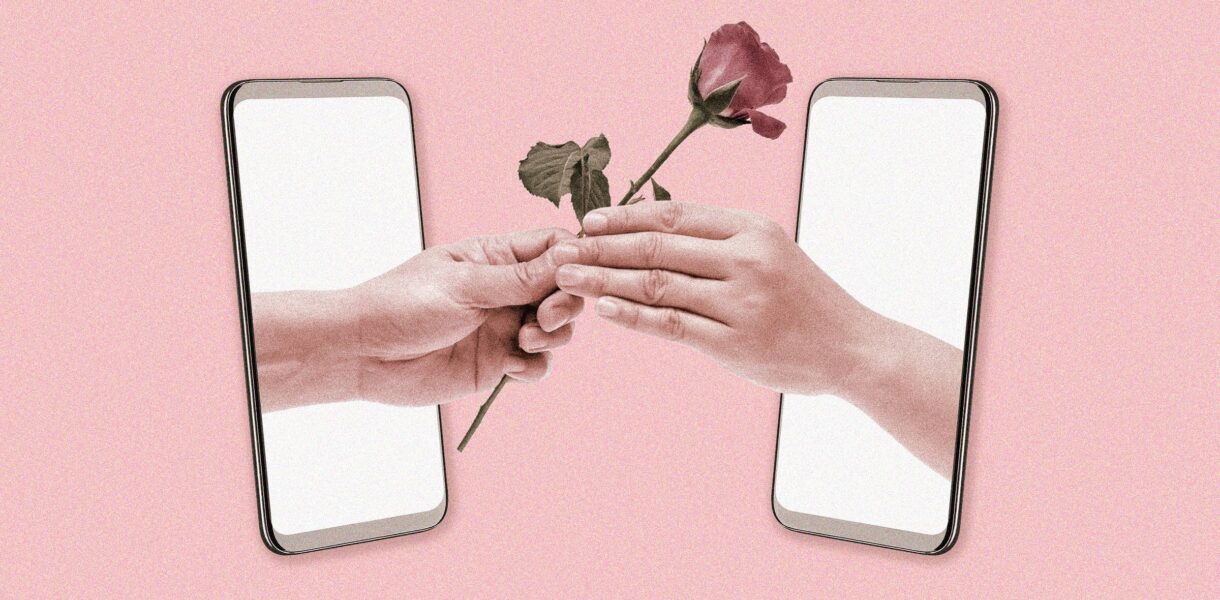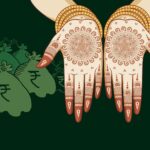
Marriage has been recognised historically and culturally, as a site of extreme gender inequalities and masculine domination. [1] One of the main avenues through which patriarchy is reinforced in marriages is through the politics of spousal selection. With a shift from traditional intermediaries, modern matchmaking platforms and dating apps have become vital spaces where people meet and connect with their intimate partners. While these platforms claim to alter the matchmaking landscape for the better and provide new social opportunities, inherent biases incorporated in technology is limiting the degree to which such opportunities can be realised in practise.[2] A close investigation into the critical infrastructures of dating apps and matchmaking websites reveals the ways in which structural biases are sustained in less obvious ways. The use of algorithms and website designs allow people belonging to similar socio-political, economical and cultural background to be matched together. [3] In critiquing the same, it is asserted that matching people within their own ethnicity is extremely problematic, for it reproduces an accepted archaic practise of caste endogamy, thereby also reinforcing deeply entrenched structural biases surrounding sexism, classism, racism and colourism.
Patriarchy in Spousal Selection
Patriarchal control is exercised over a woman as soon as the process of spousal selection is initiated. While both the groom and the bride side experience societal norms and pressures, more often it is the bride’s side than the groom’s side. A matrimonial event organised by Young Achievers Matrimony, released an advertisement in the newspaper where Young Achievers or people eligible to participate need to be be beautiful girls.[4] This was a blatant discrimination, based on physical appearance of the woman. The process of interviewing a bride is certainly an objectification process, where she is scrutinized by her in laws. Surrounded by the groom’s parent and relatives, focus lies on the way she walks and talks, similar to how we examine a product before buying it. Hypocrisy is inherent where they want women who are smart and educated, however, are not as interested in her qualifications as in finding out whether she can manage household chores at the same time. The process is often concluded by statements such as “ladki pasand aayi” signifying approval or “ladki aise toh achi hai, bass thodi sundar kamm hai” or commenting upon any other random arbitrary feature of the woman in case of rejection.
While the extended family has now become less inclined to participate in the process of matchmaking, the use of internet-based services has gradually become a replacement to carry on the same process.[5] It is interesting to note the methods employed by such intermediaries in selecting a suitable partner for a prospective bride or groom. The eligibility criteria for men and women are different, which is indicative of the perpetuated gender roles. For a husband, deciding factors are generally financial stability, while for the wife, physical attributes in addition to whether she can manage the household chores is monitored. A study conducted on 100 female profiles on the matrimonial website Shaadi.com revealed the constant attempt of female users to combine seemingly contrasting aspects.[6] While describing career ambitions and adventurous hobbies, many described themselves as ‘simple girls’ who respect traditions. [Figure 1] “I am a smart, urban woman with traditional values”, “I would call myself a good mix of east and west” or “thinks rationally still values traditions.”[7] The problem originates from the fact that matrimonial websites provide checkboxes such as good looks and homely qualities to describe oneself which push women to think in this direction. The constant attempt to combine modern and traditional elements to be an ideal wife for the husband’s family has become a dominant tendency in the socio-cultural landscape of India. These emerging online platforms of intermediaries indeed create space for new forms of representation and social interaction, however still succumb to gender roles, thereby not making any attempt to curb patriarchy at all. “By manoeuvring their positions within a patriarchal framework rather than outside it, women are able to negotiate through situations of potential and real oppression and reposition themselves vis-à-vis the family, community and society at large.”[8]
FIGURE 1: SELF DEPICTION OF 100 FEMALES IN SHADDI.COM[9]
Reproduction of Caste Endogamy in Modern Matchmaking
Online matchmaking tries to showcase a shift from traditional intermediaries like brokers or friends and relatives who used to suggest partners from the same caste and background. Matchmaking websites claim to present a common medium to people of all castes and classes to interact and choose partners. However, it is ironical how all major matchmaking portals organize their search options along caste and community lines, even before the user starts surfing.[10] This is an intervention by the service provider which unnecessarily reinforces caste biases. While registering a free profile at Jeevansathi.com, the user is asked to enter the respective caste before being able to proceed. [Figure 2] This is not only the case for arranged marriages, but also for most love marriages where parental consent is given much importance and children are supposed to choose partners keeping in mind a similar caste background.
FIGURE 2: REQUIREMENT OF ENTERING CASTE WHILE REGISTERING A PROFILE AT JEEVANSATHI.COM[11]
Set aside caste, human beings also tend to make their romantic choices based on looks, socio-economic background, status, education, religious or ethnic group. The idea behind type and preference runs dangerously parallel to bias and prejudice much of whose implications are unnoticed even by the source. To begin with, their exists certain biases around elitism which reproduces the accepted archaic practise of class and caste endogamy, though not very evident on the outside. The educated upper caste-upper class have been complacent in carrying forwarding the caste and class-based prejudices while looking for partners even today. A common counter to this statement would be that it is a matter of preference to marry someone belonging to the same community and educational background, and does not necessarily make one casteist. However, one needs to question the need for such a striking similarity in all marriages. A close scrutiny of some other matchmaking sites shows that it is still very much catering to people such that they remain within a certain group, even if it is not casteist very evidently on the outside. ‘IIM IIT Shaadi’, as the name suggests, is a website where people belonging to premium academic institutions marry each other.[12] Another website, ‘Elite Matrimony’ is an exclusive matchmaking service for the rich and the affluent, which focuses on serving the privileged class. [13] B.R. Ambedkar had stated that the fundamental backbone of the Hindu religion was the caste structure, which was maintained through generations by caste endogamy.[14] Very subtly, these matchmaking sites are reinforcing the older hierarchies through modern techniques. In a very paradoxical manner, modernity is reproducing the same divisions that it is supposed to deconstruct.
Sexism in Dating Apps
Nonetheless, for those who have still not succumbed to the prejudices of matchmaking sites, dating apps have perhaps been successful in contributing just as much. In India, dating apps such as Tinder, Bumble, Happn, Truly Madly, Ok Cupid have gradually attained much popularity. [Figure 3]
FIGURE 3: SHARE OF DATING APPLICATION USERS ACROSS INDIA, 2018. [15]
Bumble is claimed to be the first ‘feminist’ dating and networking app in India. It had recently introduced the ‘women text first’ feature typically for heterosexual equations. [16] For many, this was an empowering feature for women, inadvertently giving them a certain level of power and agency with an upper hand in initiating the conversation, perhaps because they can pick and choose whom to text. [17] Following this, Tinder also launched an opt-in setting called ‘my love’ that allows women to exclusively send the first message. [18] However, this seems to be an illusionary form of women empowerment where they are put in a position of power only temporarily. Merely because a woman texts first, the rest of the conversation cannot be dictated by her and the man can always take over, immediately after the first message. On the flipside, in India, women who are forward are often seen as ‘easy’ and are repeatedly slut shamed for their ‘go-getter’ nature. [19] If the woman withdraws her consent midway, the men deploy misogynistic tendencies and engage in derogatory name calling. As a result, the sense of women empowerment that Bumble and Tinder are trying to create are becoming counterproductive.[20] Therefore, a deeper re-evaluation of the policies and structures need to be carried out so as to truly remove any prejudices.
Reproduction of Structural Biases through Algorithms
Dating apps have long allowed users to avail features to refine their matches. With the help of algorithms, they have automated settings to filter matches such that people belonging to similar social, economic and cultural background are matched together.[21] These settings allow people to reinforce their inherent structural biases. The algorithm’s assumption that people are willing and more likely to match within their own ethnicity is extremely problematic. The critical infrastructures of dating apps are not paid much attention in terms of bias and discrimination. Algorithms are not simply the technical objects and procedures that technology companies and computer scientists claim them to be. [22] They cannot escape the influence of their local context, culture and knowledge in the processes within which they are located and operate.[23] As Kitchin argues, algorithms are hardly created for any neutral purposes. They serve to create value and capital, to influence behaviour and preferences and to identify, sort and classify people.[24] In 2019, Berman, a game designer in San Francisco designed his own dating app, ‘Monster Match’ with a cast of illustrated monsters by borrowing the basic architecture of a dating app. [25]In this game, monsters match with other monsters and chat to set up dates. A peculiar feature was noticed wherein, algorithms made the field of choice narrower and a monster ended up seeing the same monster repeatedly, thereby being separated from other monsters. For instance, in the monster game, if one swipes right on a zombie and left on a vampire, then a new user who also swipes right on a zombie will never see a vampire. [26] Merely based on a second of assessment, the algorithm assumes that all people who swipe right on zombies would never swipe right on vampires. Additionally, if one swipes right on a set of profiles, more of similar profiles will be shown instead of the other profiles. Nonetheless, existing research on the subject reveals that dating apps like Tinder and Bumble use the same ‘collaborative filtering’ feature which reproduces structural biases and thereby, excludes users from a vast community of people with whom they could otherwise match well with.[27] It is based on the same logic that gives us recommendations about the movies and clothes we like based on what we have already downloaded or scrolled. The only difference is that it is much more nuanced since the recommendation is not just with respect to movies or clothes but real choices of human beings and life partners.
As a result, once again it is the minority group upon whose trauma the designers of dating apps capitalise. No wonder, in the stereotypical society of India, it is either the dark skin of the person, or some other physical attribute which narrows the user’s choices of partners, thereby separating the user from the remaining pool of candidates. Ironically, social apps should be one platform where greater diversity can be expected. While Tinder claims that it does not believe in stereotypes and thus, does not take income, race or religion into consideration[28], it cannot be assumed that its algorithms do not reproduce the same prejudices. A mere design of the app can make users feel unsuccessful and lonelier without actually being aware of the technological complexities. Colourism, the bias against people of darker skin tones has been existing in India since the colonial rule. More often than not, it is expected of a woman, more than a man, to be fair and beautiful. This has been reinforced by caste, regional differences and of course, Bollywood. Dating app designers capitalise on this notion and make skin colour important in a very peculiar way. After noting a pattern, the algorithm will absolutely eliminate dark skinned woman to appear in man’s profile. Nonetheless, matches are filtered similarly based on other ugly biases of race, caste, class, age and region. [29]
When people are given the option to avail a particular filter, their temptations are bound to succumb to it. Instead, why can’t the particular filter be scraped altogether. This is not a criticism of individual preferences, but how preferences are being eventually shaped. Culture shapes our preferences and dating apps influence our decisions. Designers are able to find an escape through the prevalent notion that romantic and sexual choices are intensely personal being outside the scope of preferences that these platforms pass on. Indeed, intimacy is supposed to be private, however, our private lives have large impacts on the socioeconomic patterns that are systematic. One needs to ponder on the question that why is it so important for two people to be absolutely common in terms of all external factors, why cannot two completely different people first talk and then decide compatibility. If only, users are allowed to at least look at diverse profiles and them make a choice, instead of eliminating them altogether. There can be several other factors that people might find attractive about one another. For someone, things such as skin colour, physique, or race might not be a deciding factor at all. Berman suggested that a mere reset button that erases history with the app or a simple opt out feature that lets a user turn off the recommendation algorithm has the potential to bring about a huge change. [30]
Need for Addressing Infrastructural Failures
While users pay to discriminate, either consciously or subconsciously, the institutions designing dating apps and providing matchmaking services deliberately capitalise on the trauma. With the growth of these platforms, there with also be a growth on their influence on individuals and further reproduction of structural biases. Fellow users, who participate subconsciously need to be made aware of how they end up discriminating and pose serious challenges upon the society. It is time for users to acknowledge that preferences are fluid to be able to look beyond individual differences. The need for addressing the critical infrastructures of these apps and websites is further amplified due to the COVID 19 pandemic, where online dating and matchmaking has gained fresh momentum since the lockdown began. [31]Exploring structural instead of individual interventions will allow us to move beyond debates of individual preferences versus discrimination, and toward conversations that are concerned with how these preferences and practises arise in the first place.[32] The institutions of these service providers should discourage discrimination and patriarchy by offering users unbiased categories to describe themselves and have community inclusive algorithms. In attempting to expose the biased way modern matchmaking services and online dating is practised, an effort has been made to highlight the need for investigating infrastructural failures of algorithms and web designs. Understanding how they produce effects can indeed be very challenging due to scientific secrecy and their complex, cumbersome nature, however, with detailed research on this subject, software designers could work towards building new forms of algorithm design mechanisms for dating apps and matchmaking platforms that mitigate the inherent forms of discrimination. Indeed, getting rid of filters will not eliminate discrimination and in-group matchmaking, however, it will at least make the society less segregated and push people in the right direction.
About The Author
Photo Credits:Texas Monthly
References
-
Mukta Sharangpani, Browsing for Bridegrooms: Matchmaking and Modernity in Mumbai, 17 IGJS. 249-276 (2010). ↑
-
Ashley Brown, Least desirable? How racial discrimination plays out in online dating, NPR, (January 9, 2018), https://www.npr.org/2018/01/09/575352051/least-desirable-how-racial-discrimination-plays-out-in-online-dating. ↑
-
Jevan Hutson, Jessie G. Taft, Solon Barocas & Karen Levy, Debiasing Desire: Addressing Bias & Discrimination on Intimate Platforms, 73 CSCW. 1-18 (2018). ↑
-
Geetika Mantri, We made a mistake: Mr Sreeram, man behing viral ‘Young Achievers Matrimony’ ad, The News Minute, (July 25, 2018), https://www.thenewsminute.com/article/we-made-mistake-mr-sreeram-man-behind-viral-young-achievers-matrimony-ad-85419. ↑
-
Bhawna Jaimini, Can Dating and Marriages in India Ever Be Without Biases, She the People, (July 29, 2020), https://www.shethepeople.tv/home-top-video/indian-matchmaking-stereotypes-caste/. ↑
-
Fritizi Marie Titzmann, Matchmaking 2.0, The Representation of Women and Female Agency in the Online Matrimonial Market, 42 IA. 1-18 (2011). ↑
-
Id. ↑
-
Supra note 1. ↑
-
Supra note 6. ↑
-
Anuja Agarwal, Cyber-matchmaking among Indians: Re-arranging marriage and doing ‘kin work’, 13 SAPC. 15-30 (2015). ↑
-
<https://www.iitiimshaadi.com/> ↑
-
<https://www.elitematrimony.com/> ↑
-
B.R. Ambedkar, Castes in India; Their Mechanisms, Genesis and Development, 1916. ↑
-
<https://www.statista.com/statistics/987729/india-share-of-dating-application-users-by-region/#:~:text=In%20north%20India%2C%20Tinder%20was,during%20the%20measured%20survey%20period.> ↑
-
Rena Bivens & Anna Shah Hoque, Programming Sex, Gender, and Sexuality: Infrastructural Failures in the “Feminist” Dating App Bumble, 43 CJC. 441-459 (2018). ↑
-
Janhavi Sharma, Bumble’s Women-First Features Are Great, But Is That Enough?, Feminism in India, (September 8, 2020), https://feminisminindia.com/2020/09/08/is-bumble-truly-a-feminist-dating-app/. ↑
-
My Move: Tinder lunches extra control for women in India, Hindustan Times Tech (September 25, 2018), https://tech.hindustantimes.com/tech/news/a-swipe-is-not-enough-tinder-trials-extra-control-for-women-in-india-story-ZeeGn95IlxabBadtGWeiaI.html. ↑
-
Supra note 17. ↑
-
Supra note 16. ↑
-
Supra note 3. ↑
-
Sokfa F. John, Computing Cupid: Online Dating and the Faith of Romantic Algorithms, 25 AJGR. 86-108 (2019); David Beer, The Social Power of Algorithms, 20 ICS. 1-13 (2017). ↑
-
Rob Kitchin, Thinking Critically about and Researching Algorithms, 20 ICS. 14-29 (2017). ↑
-
Id. ↑
-
Arielle Pardes, This Dating App Exposes the Monstrous Bias of Algorithms, (May 25, 2019), https://www.wired.com/story/monster-match-dating-app/.; <https://monstermatch.hiddenswitch.com/home> ↑
-
Id. ↑
-
Supra note 3. ↑
-
Tinder, Powering Tinder – The Method Behind Our Matching, Blog Gotinder, (March 15, 2019), https://blog.gotinder.com/powering-tinder-r-the-method-behind-our-matching/. ↑
-
Supra note 3. ↑
-
Supra note 25. ↑
-
Online Dating: How the world of online dating has changed during the pandemic, Times of India, (November 15, 2020), https://timesofindia.indiatimes.com/life-style/health-fitness. ↑
-
Supra note 3. ↑




